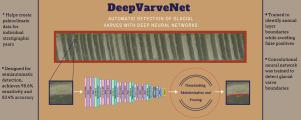当前位置:
X-MOL 学术
›
Comput. Geosci.
›
论文详情
Our official English website, www.x-mol.net, welcomes your feedback! (Note: you will need to create a separate account there.)
DeepVarveNet: Automatic detection of glacial varves with deep neural networks
Computers & Geosciences ( IF 4.4 ) Pub Date : 2020-11-01 , DOI: 10.1016/j.cageo.2020.104584 Anna Fabijańska , Andrew Feder , John Ridge
Computers & Geosciences ( IF 4.4 ) Pub Date : 2020-11-01 , DOI: 10.1016/j.cageo.2020.104584 Anna Fabijańska , Andrew Feder , John Ridge

|
Abstract Varves – annual sediment layers, common in glacial lakes – are an important source of paleoclimate information. Manually recording their occurrence, typically by visual inspection, can be both time-consuming and prone to error, leading to several attempts in recent years to at least partially computerize the process. However, existing computerized methods of varve detection still require moderate to large amounts of user interaction — they are semi-automated, rather than fully automated. In light of that, this paper is a step towards fully automatic detection of varves. The presented program, DeepVarveNet - a glacial varve detector built on a convolutional neural network, is designed to automatically delineate annual layers in such lacustrine sediment in digital images of photographed sediment cores. To the best of the authors’ knowledge, this is the first approach that applies a convolutional neural network to this task. The performance of DeepVarveNet was assessed on a data set comprising images from seven sediment coring sites, of varying sedimentological properties. They represent three northeast U.S. glacial paleolakes, and glacial paleolake Ojibway. Our testing set contained 1415 identified varves, on which DeepVarveNet demonstrated sensitivity at a level of 0.986 and precision equal to 0.834, exceeding that of BMPix and ANFIS, the existing semi-automated varve identifiers.
中文翻译:

DeepVarveNet:使用深度神经网络自动检测冰川斑纹
摘要 Varves——冰川湖中常见的年度沉积层——是古气候信息的重要来源。手动记录它们的发生,通常是通过目视检查,既费时又容易出错,导致近年来多次尝试至少部分地将过程计算机化。然而,现有的 varve 检测计算机化方法仍然需要中到大量的用户交互——它们是半自动的,而不是全自动的。有鉴于此,本文是朝着全自动检测varves迈出的一步。所提出的程序 DeepVarveNet - 一种建立在卷积神经网络上的冰川斑纹探测器,旨在在拍摄的沉积岩芯的数字图像中自动描绘此类湖泊沉积物中的年层。据作者所知,这是将卷积神经网络应用于此任务的第一种方法。DeepVarveNet 的性能是在一个数据集上进行评估的,该数据集包含来自七个沉积物取心点的图像,具有不同的沉积学特性。它们代表了美国东北部的三个冰川古湖和奥吉布韦冰川古湖。我们的测试集包含 1415 个已识别的 varve,DeepVarveNet 在其中表现出 0.986 的灵敏度和 0.834 的精度,超过了现有的半自动 varve 标识符 BMPix 和 ANFIS。和冰川古湖奥吉布韦。我们的测试集包含 1415 个已识别的 varve,DeepVarveNet 在其中表现出 0.986 的灵敏度和 0.834 的精度,超过了现有的半自动 varve 标识符 BMPix 和 ANFIS。和冰川古湖奥吉布韦。我们的测试集包含 1415 个已识别的 varve,DeepVarveNet 在其中表现出 0.986 的灵敏度和 0.834 的精度,超过了现有的半自动 varve 标识符 BMPix 和 ANFIS。
更新日期:2020-11-01
中文翻译:

DeepVarveNet:使用深度神经网络自动检测冰川斑纹
摘要 Varves——冰川湖中常见的年度沉积层——是古气候信息的重要来源。手动记录它们的发生,通常是通过目视检查,既费时又容易出错,导致近年来多次尝试至少部分地将过程计算机化。然而,现有的 varve 检测计算机化方法仍然需要中到大量的用户交互——它们是半自动的,而不是全自动的。有鉴于此,本文是朝着全自动检测varves迈出的一步。所提出的程序 DeepVarveNet - 一种建立在卷积神经网络上的冰川斑纹探测器,旨在在拍摄的沉积岩芯的数字图像中自动描绘此类湖泊沉积物中的年层。据作者所知,这是将卷积神经网络应用于此任务的第一种方法。DeepVarveNet 的性能是在一个数据集上进行评估的,该数据集包含来自七个沉积物取心点的图像,具有不同的沉积学特性。它们代表了美国东北部的三个冰川古湖和奥吉布韦冰川古湖。我们的测试集包含 1415 个已识别的 varve,DeepVarveNet 在其中表现出 0.986 的灵敏度和 0.834 的精度,超过了现有的半自动 varve 标识符 BMPix 和 ANFIS。和冰川古湖奥吉布韦。我们的测试集包含 1415 个已识别的 varve,DeepVarveNet 在其中表现出 0.986 的灵敏度和 0.834 的精度,超过了现有的半自动 varve 标识符 BMPix 和 ANFIS。和冰川古湖奥吉布韦。我们的测试集包含 1415 个已识别的 varve,DeepVarveNet 在其中表现出 0.986 的灵敏度和 0.834 的精度,超过了现有的半自动 varve 标识符 BMPix 和 ANFIS。


























 京公网安备 11010802027423号
京公网安备 11010802027423号